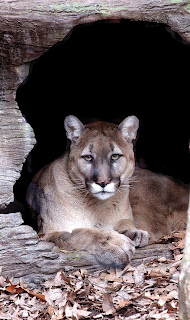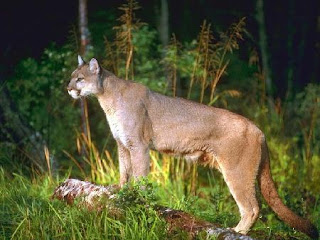Photo courtesy of turtletracks.org
Eastern Cougar, Photo courtesy of the
North Carolina Museum of History
 Last month in my article “Living with Wildlife,” I talked about the many times that my family and friends have seen mountain lions here in the Berkshires. The big cat roaming our region is called the Eastern Cougar (Felis concolor couguar), and was once found in abundance in the east from the southern Appalachians to New Brunswick, Canada. Also known as the “cat of many names”, the cougar, depending on the region, is referred to as mountain lion, puma, mountain screamer, brown tiger, catamount, silver lion, mountain demon, king cat, sneak cat, and panther. Their character is to be cunning, determined, shrewd, sly, and solitary. Usually silent, the cougar can produce many kinds of calls, including screams, hisses, and growls. It also utters a shrill, piercing whistle.
Last month in my article “Living with Wildlife,” I talked about the many times that my family and friends have seen mountain lions here in the Berkshires. The big cat roaming our region is called the Eastern Cougar (Felis concolor couguar), and was once found in abundance in the east from the southern Appalachians to New Brunswick, Canada. Also known as the “cat of many names”, the cougar, depending on the region, is referred to as mountain lion, puma, mountain screamer, brown tiger, catamount, silver lion, mountain demon, king cat, sneak cat, and panther. Their character is to be cunning, determined, shrewd, sly, and solitary. Usually silent, the cougar can produce many kinds of calls, including screams, hisses, and growls. It also utters a shrill, piercing whistle.With three wildcats in our area, the Bobcat, Canada Lynx, and the Eastern Cougar, they can easily be confused with each other unless you can recognize the differences in these cats. The cougar is almost unmistakable - when you truly see one, you know it, by the large size, long, thick tail (up to 3ft. long) and the solid color body. Tawny colored and lithe, the animals may reach a length of nine feet and weigh more than 150 pounds. Rarely are there any markings on the body, only the face, where there are dark black areas around the eyes and across the nose. A bobcat can have a tail length of 3 ½ inches (a “bob”) or it can be up to 7 ½ inches long – at the longer lengths it does not really look like the stubby type tail most people think of when they picture a bobcat. Bobcats have spotted and striped markings, and seldom have any solid color areas, they can also have little tufts, or spikes of hair at the tips of their ears. The bobcat is smaller than a cougar – a full size, adult bobcat weighs anywhere from 15 to 35 pounds and can be between three to four feet in length.
The Canada lynx in our area are slightly smaller than a bobcat, and have very distinctive long spikes of hair at the tips of their ears, as well as long pointed tufts of fur around the jowl line. The lynx ‘s coat has longer hair than a cougar or bobcat and can have markings similar to bobcats, although the most common colors are light gray, silver, or brown with streaks of black and white. Mass Wildlife claims the only cat in Massachusetts is the bobcat – I beg to differ, as many others will too, that have seen all three of these cats in our area.
Bobcat, Photo courtesy of Mass DNR

Early in the 20th century, the cougar, hunted intensively, and extirpated from the East, (except south Florida), was considered by some to be extinct. However, “cougar sightings in remote areas never completely ceased. By the 1960s, sightings had increased to the point that the eastern cougar was believed to possibly still exist and was listed on the first Endangered Species Act in 1973.” Cougars prey on hares, tree porcupines, deer, and rodents for substantial portions of the diet. Where there are free roaming domestic cattle, they rank high on the list of prey animals for the cougar. The killing of livestock is one of the principal reasons for human aggression against the cats. The Eastern Cougar Foundation states, “fatal cougar attacks are extremely rare: 19 human deaths have been documented in the past 500 years. In comparison, dogs kill 18 to 20 humans every year.”
The Nature Conservancy’s organization “The Berkshire Taconic Landscape” acknowledges the presence of the mountain lion in Berkshire County, and its’ expected influx into our area in their future predictions for our region. Their website claims that “The Berkshire Taconic Landscape is recognized by The Nature Conservancy as one of the world’s ‘Last Great Places’ – that is, one of the most significant natural areas in the United States, selected as a conservation priority due to its health and biodiversity.” The Conservancy’s ecological vision for the forests of our landscape suggests that in 50 years “forest interior nesting birds and wide-ranging predators – bear, bobcat, fisher, and mountain lion – will find the landscape a prosperous place to live.” However, the Conservancy also states, “the landscape is under increasing pressure to develop; studies in some towns show that at current rates of change, ALL developable land will either be conserved or developed, in less than twenty years. Developments of fundamental regions these animals inhabit are driving them out of the mountain ranges and hillsides of Berkshire County. We are building right in their homes and territories and they have nowhere to go but down off the mountains and into our villages. This is why we are seeing more of the large wildlife roaming amongst us, showing up in populated areas. Sadly, it is our fault as human beings (we are the most dangerous predator to all wildlife) that these animals are disrupted and displaced. We drive them out of their forest homes, they show up near ours, and people become alarmed and angry, and do not want wildlife in their country environment, and so some uneducated people think the only solution is to kill the animals, and unfortunately this happens all too often.
For more information on Eastern Cougar Foundation, visit the ECF website at http://www.easterncougar.org/., or write the Eastern Cougar Foundation, P.O. Box 91, North Springs, WV 24869. We have cougars in Berkshire County, there is no doubt, I could list a few dozen people that have sighted cougars in Southern Berkshire County. If you have seen an eastern cougar, you can help by reporting it via email at: scb01489@mail.wvnet.edu.or use the cougar report hotline of the Eastern Cougar Foundation at 304-664-3812.
Canada Lynx, Photo courtesy of NPS.gov
The Nature Conservancy’s organization “The Berkshire Taconic Landscape” acknowledges the presence of the mountain lion in Berkshire County, and its’ expected influx into our area in their future predictions for our region. Their website claims that “The Berkshire Taconic Landscape is recognized by The Nature Conservancy as one of the world’s ‘Last Great Places’ – that is, one of the most significant natural areas in the United States, selected as a conservation priority due to its health and biodiversity.” The Conservancy’s ecological vision for the forests of our landscape suggests that in 50 years “forest interior nesting birds and wide-ranging predators – bear, bobcat, fisher, and mountain lion – will find the landscape a prosperous place to live.” However, the Conservancy also states, “the landscape is under increasing pressure to develop; studies in some towns show that at current rates of change, ALL developable land will either be conserved or developed, in less than twenty years. Developments of fundamental regions these animals inhabit are driving them out of the mountain ranges and hillsides of Berkshire County. We are building right in their homes and territories and they have nowhere to go but down off the mountains and into our villages. This is why we are seeing more of the large wildlife roaming amongst us, showing up in populated areas. Sadly, it is our fault as human beings (we are the most dangerous predator to all wildlife) that these animals are disrupted and displaced. We drive them out of their forest homes, they show up near ours, and people become alarmed and angry, and do not want wildlife in their country environment, and so some uneducated people think the only solution is to kill the animals, and unfortunately this happens all too often.
For more information on Eastern Cougar Foundation, visit the ECF website at http://www.easterncougar.org/., or write the Eastern Cougar Foundation, P.O. Box 91, North Springs, WV 24869. We have cougars in Berkshire County, there is no doubt, I could list a few dozen people that have sighted cougars in Southern Berkshire County. If you have seen an eastern cougar, you can help by reporting it via email at: scb01489@mail.wvnet.edu.or use the cougar report hotline of the Eastern Cougar Foundation at 304-664-3812.
Canada Lynx, Photo courtesy of NPS.gov










No comments:
Post a Comment